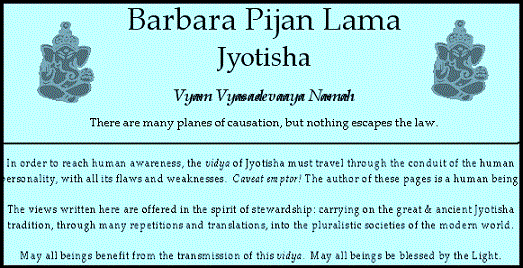
विम्शोत्तरि दशा
Rahu-Ketu bhukti: A Time of Two Minds
Rahu-Ketu: Directory of
Jyotisha Descriptions
Reflections on
Predicting
the Effects of Ketu period
Rahu-Ketu gochara
Trimshamsha lagna
What to expect (in general) during bhukti of Ketu:
Ketu Mahadasha
according to Parashara
Rahu-Ketu Amplify, magnify, and exacerbate the fluctuations
of Manas, the Moon. Rahu is always, if reluctantly," seeing" by drishti His
Other Half, shri Ketu. Ketu is always, if somewhat mutely," seeing" His Other
Half, shri Rahu.
Rahu periods and Ketu periods are dominated by two-ness, the bifurcated
mental state of being in bondage to another personality - usually someone with
dangerously different or incompatible objectives.
Psycho-mental Bondage of Rahu-Ketu
In
Rahu periods,
it is a bondage of desire for the Other . The mind is
enflamed with a hunger for material power and sensually indulgent experience.
The object of desire may be the affections of a human being, aform of power such
as magical or political or financial capability, atype of sensual experience
such as sexual or travel or the exhilarating, satiating, drug-like effects of
food and drink.
At the higher levels of consciousness, the Learner realizes their
incarnational bondage to egoic-mind desire-Mind as a tremendous obstacle to
enlightenment.
Although one accepts the need for an orderly expression of the Mind's desires
as the inevitable play-out of the Rules of the Game, one achieves a
neutral acceptance of the inevitability of sensual-desire-Mind without
feeling entangled in it or enslaved to it.
In
Ketu periods,
it is a bondage of resentful servitudeto the Other .
The mind is obsessed with an unresponsive, withholding, always-promising but
never providing partner of some type. The partner may be a human being, adeity,
amaterial goal, or the Mind itself.
(The projected object = described by Ketu's incoming drishti, rashi and
bhava.) At the higher levels of consciousness, one may realize their incarnational
bondage to image-projection-Mind as a tremendous weight and obstacle to
enlightenment.
Ideally, one achieves a neutral acceptance of the inevitability of
image-projection-Mind without feeling entangled in it or enslaved to
it. If this neutral realization is achieved, bhukti of wandering Ketu can induce
deep calm.
Rāhu
During Rahu periods - whether the longer 18-year mahadasha or any Rahu bhukti
- the Learner is attractive and attractable.
Risk-rewarding Rahu increases the desire energy.
Details of Rahu 's position -
lordship, rashi, drishti etc. - will explain
the nature of the desire
and its object.
According to the nature of Rahu in the individual nativity, aRahu period will
enflame one's particular desires. Unless the Learner is super-conscious, Rahu tends to embroil one in intrigue and a sticky web of
fascinating desires.
One will connect most intensely with Others who are themselves experiencing
Vimshottari periods of Rahu, Ketu, or Shukra .
Rahu also imbues the various relationships that serve as vehicles for desire
expression with a sense of urgency and drive toward
The promise of intense satisfaction .
Myth of Rahu-Ketu
When forecasting the effects of Rahu and Ketu periods, keep in mind the
narrative of this myth and its structural dynamic of attraction *
akarshana *and repulsion * vikarshana
* .
Rahu has a passionate desire for the
Amrita
or nectar of divine life, which causes Him to break all the rules.
Professor Rahu is an impostor. Rahu-desire is not a divine
force. But, in human life, professor Rahu often tricks His students into
thinking that Desire will lead to divine enlightenment! In fact, the opposite is
true: desire almost always leads to more desire.
Desire is the single leading cause of reincarnation.
Good desires, bad desires, all desires are Rahu :)
Even morally 'good' desires are still desires, and they still force
reincarnation.
Even the 'last time around' type of desires, such as the desire to relieve
the suffering of others or the desire to repay one's own akashic-memory debt,
are still the causes of return to the cycle of birth and death. Yes these are
praiseworthy desires but they still have the same mechanical force as any other
desire, which is to get the spirit entrapped in a whole complex of incarnational
delusions.
A tragic narrative:
Rahu's desires are partiallysatisfied, but it is Rahu's nature to
Always want more. Before Vishnu's discus slices the snake-god Rahu in half
(thus creating Ketu from Rahu's tail), Rahu does get that drop of amrita. But
His power to join the divine celebration is forever destroyed.
Saints and the rest of us:
For a great saint, Rahu may enflame their desire to relieve human suffering.
Rahu is usually the culprit behind extreme saintly actions like self-immolation
in political protest.The saint is possessed by a powerful desire, and might do
pretty much anything in their passion to reach their goal.
For the average person, Rahu often functions as Shukra's 'evil twin',
stimulating sensual passions, extramarital affairs and provoking impulsive
marriages. At the very least one's social life tends to increase because one is
perceived as desirable. Even people who are normally shy and retiring will
surprise the public with rather sudden bursts of passion during Vimshottari
periods of Rahu.
Sometimes Rahu is positioned to crave not love but rather He wants
cintamani * mani * money
or raw power, or some other egoic-mind membrane food. Whatever Rahu wants
will be vigorously pursued without much concern for others.
Forewarned is forearmed:
Rahu is neither good nor bad in the big picture. However, Rahu is always
intense. It's good to be aware of the mechanics of Rahu, to prepare to negotiate
Rahu periods when they come around.
Moral justification/rationale:
he supposed reasoning behind Rahu's desire-driven actions usually follows the
line of 'love conquers all' or 'I deserve it' or 'nothing ventured, nothing
gained' or 'life is too short ' etc.
Rahu periods are naturally impulsive and not reasonable, therefore actions
may disregard the Law. Rahu periods are famous for errors in moral reasoning
such as 'the end justifies the means'. For the conscious psychic Rahu gives
major 'growth periods'. (In the psychic community, 'growth period' is a
euphemism for people who are being childish or manipulative or otherwise
impossible!)
What to expect (in general) during bhukti of Ketu:
Ketu is mokshakaraka,
the significator of spiritual liberation. Ketu periods are very effective
for
meditation, and very frustrating for everything else.
Ketu supports and rewards a wide variety of observer-intensive spiritual
practices. Ketu bhukti is always a fertile time to pursue psychotherapy and
other forms of reflective interior healing. However, even for very alert people,
Ketu periods will generally produce some disturbances on the external social and
material planes.
Shri Ganesha is the remover of obstacles. He is also the facilitator, when He
is acknowledged, of
tremendous gains
in consciousness. The primary obstacle to achieving the bliss of
spiritual merger with the divine is attachment to material delusion. So, when
Shri Ganesha enters his rulership period, He will direct Ketu to detach us from
delusions on the emotional, social-psychological, physical, and material planes.
Ketu's specific detachment/dysfunction depends on His rashi, bhava, drishti's
etc., but Shri Ganesha' s effects overall are unmistakable: the person becomes
disengaged from external perceptions of material reality and focused on internal
perceptions of psycho-spiritual truth.
Common expressions of Ketu periods are loss of self-confidence and a
wavering, uncertain social behavior distinguished by lack of motivation, poor
follow-through, etc. Here something very GOOD is happening spiritually for those
who are able to identify it.
The person' s awareness has shifted very predominantly into observer mode.
But also something quite dysfunctional according to normal social standards
is happening. The person is not actively participating in the socially-validated
behaviors of egoic-mind development, acquisition of material goods, making and
keeping of promises, being on time, other social-psychological conformist
behaviors.
Most people are social creatures, so a shortfall in social
validation during Ketu's period can result in serious depression, anxiety,
and seemingly irretrievable lack of self-esteem.
The tantric elite in certain vivid imagistic
meditation traditions can become dynamically engaged in communication with
spirits. For this elite Ketu periods are delicious, delightful, and
supremely validating
. For the rest of us who have many elaborate egoic-mind attachments to the
material world, especially the world of public opinion based on personal
productivity, Ketu can be very destabilizing. Many people with strong but
unconscious Ketu effects will turn to tamasic practices such as escape drugs,
alcohol, long sleeps etc. To avoid the social-psychological pain of Ketu-genic
alienation.
Nine Antaradashas (Bhukti, or sub-dashas) of
Rahu Mahadasha
effects of Rahu-Ketu Vimshottari Periods

[How Readings Work] = [Sample Sacred Jewels Ratna Recommendation] = [Seva]
file update =
08-Nov-2025

[Copyright 1994-2094 by Barbara Pijan Lama] = [Contact] = [How to Request a Jyotishavidya Reading]
Barbara Pijan Lama Jyotishavidya Vedic Astrology Surya Sun Chandra Moon Mangala Mars Budha Mercury Guru Jupiter Shukra Venus Shani Saturn Rahu Ketu Graha Planets Dasha Timeline Calendar Nakshatra Navamsha Marriage Children Treasury Career Spiritual Wisdom Cycles of re-Death and re-Birth
The information on barbarapijan.com , including all readings and reports, is provided for educational purposes only. Wishing you every happiness and continuing success in studies!